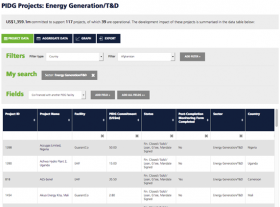
Energy
Modern, affordable, reliable and sustainable energy is critical for economic growth.
PIDG commitments by sector: 2017 ($m) - Energy
| Energy | 253.2 |
| Of which | |
| Renewable energy | 61.1% |
| Solar | 141.0 (55.7%) |
| Hydropower | 7.6 (3.0%) |
| Wind | 6.1 (2.4%) |
| Geothermal | 0.1 (0.0%) |
| Biomass | - |
| Non-renewable energy | 98.4 (38.9%) |
| Energy represents the largest proportion of PIDG’s commitments by sector. With an increasing focus on renewable energy, PIDG is delivering a positive impact on people’s lives. | |
PIDG commitments by sector: cumulative ($m) - Energy
| Energy | 1,412.60 |
| Of which: | |
| Renewable energy | 542 |
| Solar | 220.0 (15.6%) |
| Hydropower | 202.8 (14.4%) |
| Wind | 49.8 (3.5%) |
| Geothermal | 39.3 (2.8%) |
| Biomass | 30.1 (2.1%) |
| Non-renewable energy | 870.6 (61.6%) |
| In 2017, PIDG's commitments supported multiple solar projects focused on delivering mini grid and off-grid electricity to villages and people who might otherwise have limited or no access to energy. | |
Results Monitoring Database

Select, customise and analyse Energy Generation/T&D data from all PIDG-supported projects to meet your own requirements.
Explore energy dataPIDG’s focus to date has largely been on the energy sector, always preferring renewables where they make sense from a cost and grid perspective. With one in seven people globally lacking access to electricity, and as the demand continues to rise, there needs to be a substantial increase in the production of renewable energy across the world. As such, power will remain an important part of the PIDG portfolio, as it is a powerful enabler of infrastructure development and impact. We will not invest in coal-fired energy generation under any circumstances, in view of its very high greenhouse gas emissions.
We aim to provide affordable power, while always evaluating the potential climate impact, to increase supply in the most challenged countries, while contributing towards SDG 7, ‘affordable and clean energy’. We recognise that for some projects the primary pathway to impact will be through demand by businesses, while for others the main impact will be through providing energy for households. In many cases, both will be equally important for the success of a project.
Renewable generation can also avoid the need to construct large-scale centralised grid infrastructure, given its suitability for distributed or off-grid/microgrid-based generation. With nearly 80% of those lacking access to electricity based in rural areas, off-grid renewables solutions are a critical route to electrification. Scalable distributed solar solutions, often utilising innovative technologies and business models, such as pay-as-you-go, can also deal with underlying investment such as payment risk, since individuals in the region typically lack credit histories.
With an increasing focus on renewables and off-grid technologies, we will continue to develop areas where we have acquired expertise (small hydro, wind, solar, geothermal), but we will not just focus on utility-scale; we will increasingly explore off-grid and mini-grid solutions, including storage solutions co-located with renewable generation, thereby providing power in remote areas.
With nearly
80%
of those lacking access to electricity based in rural areas, off-grid renewables solutions are a critical route to electrification
